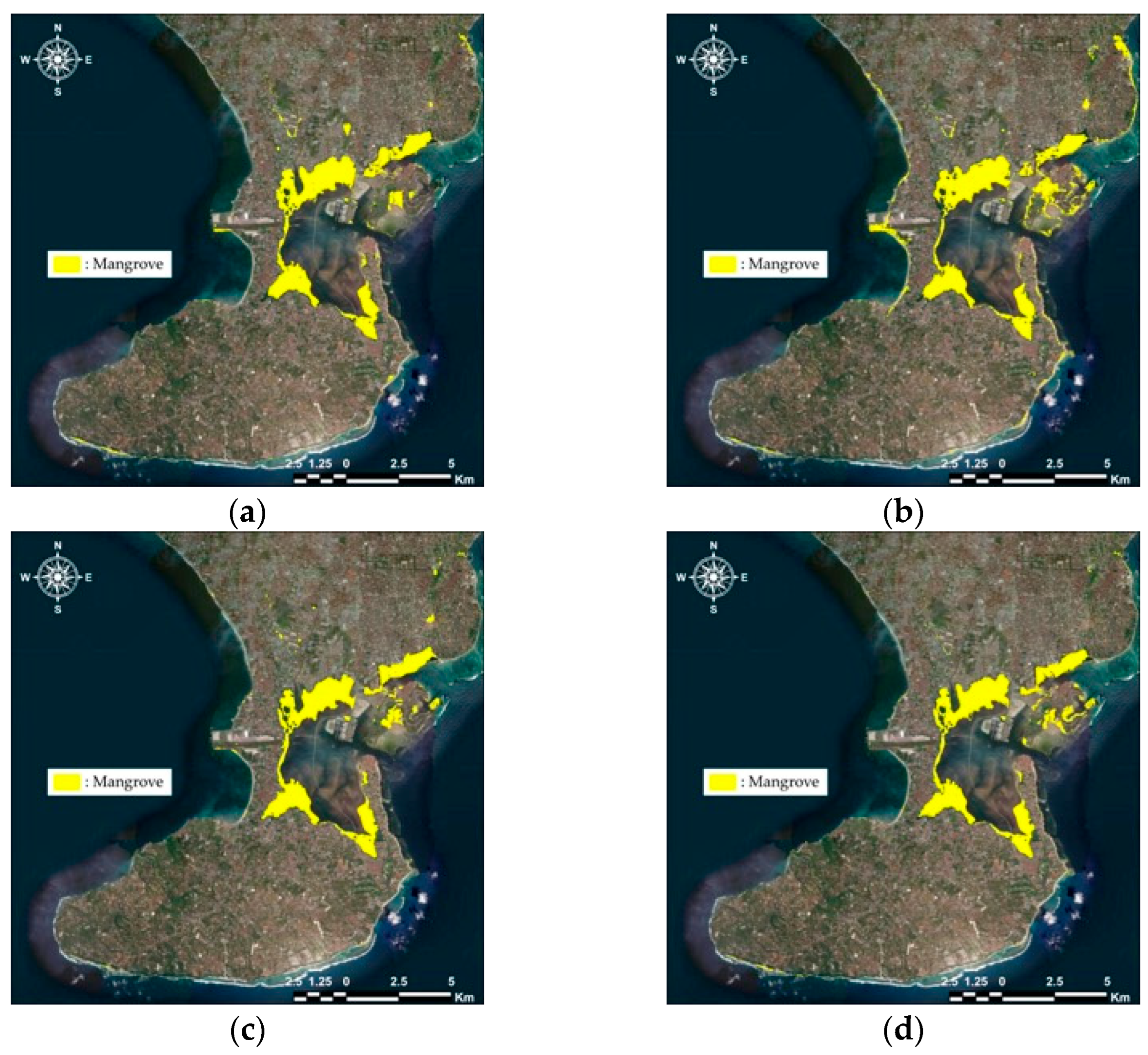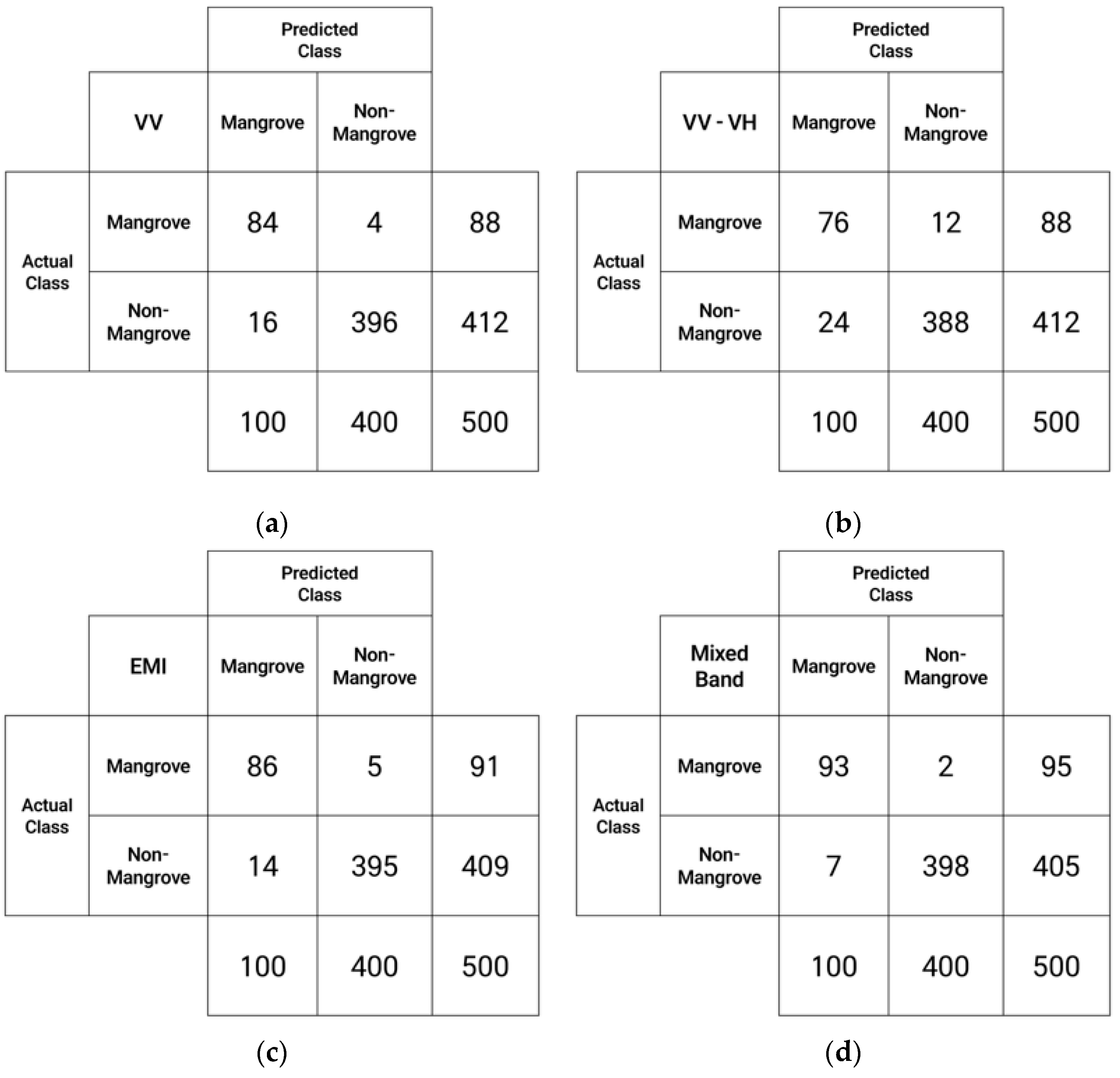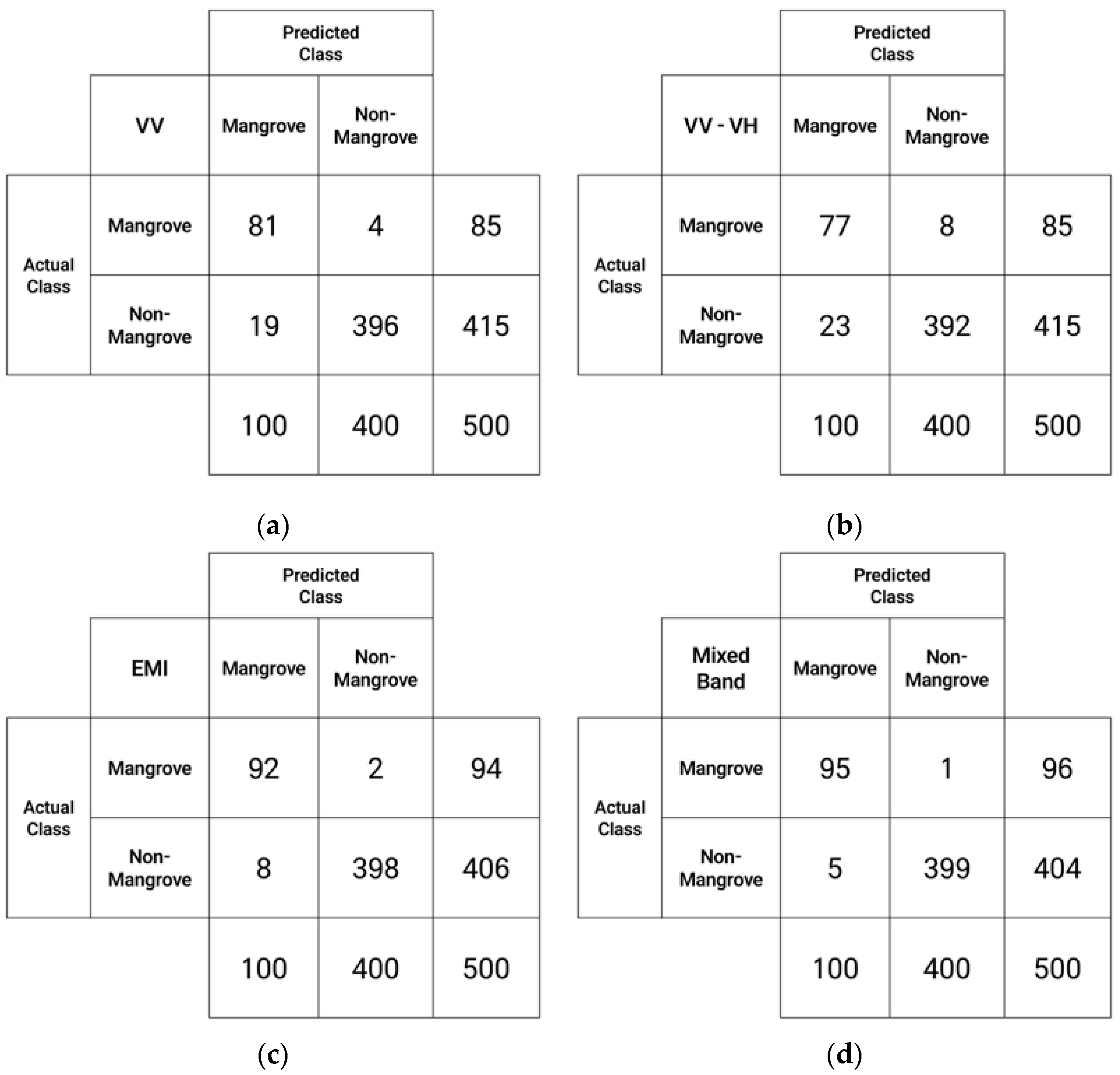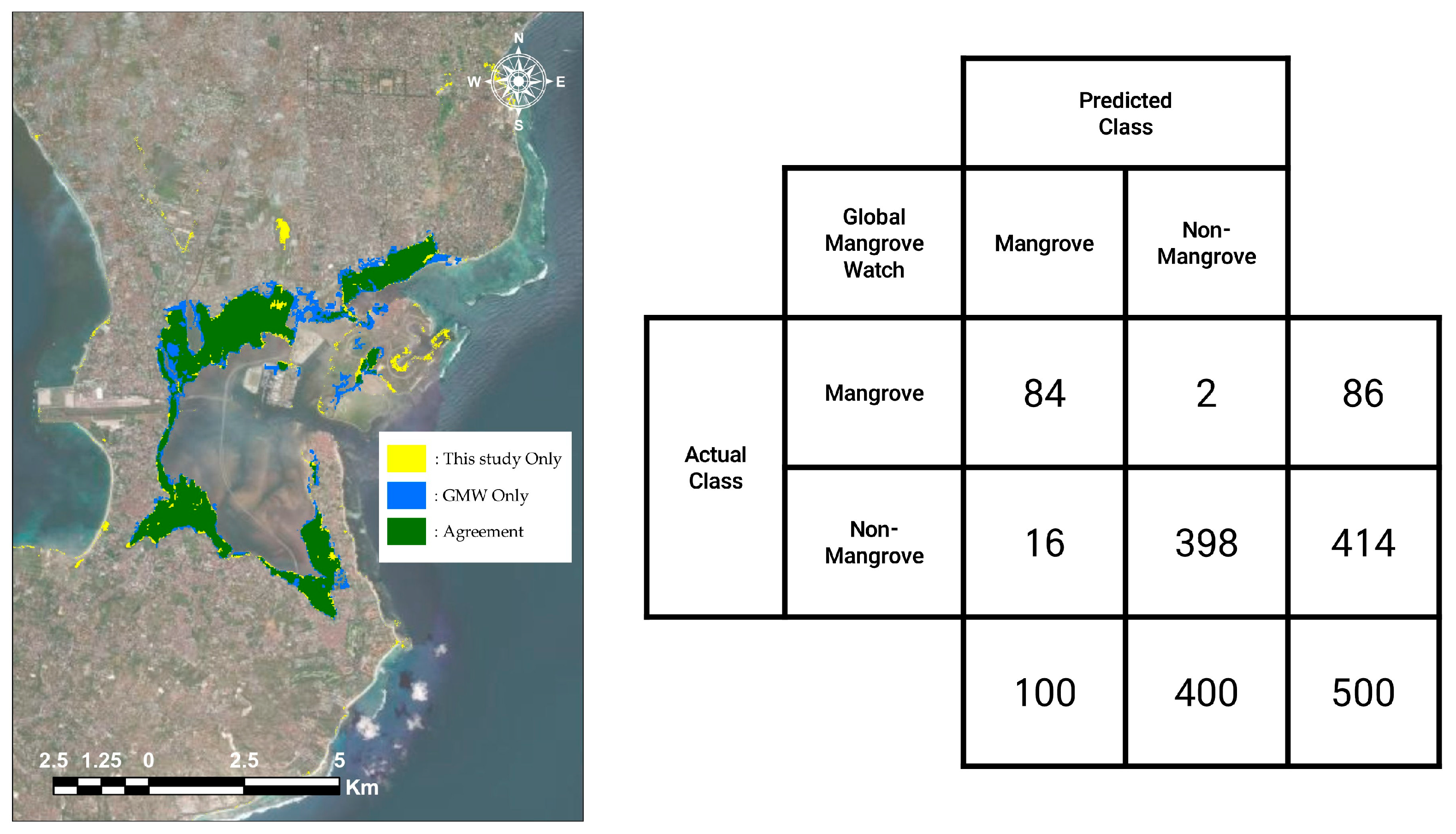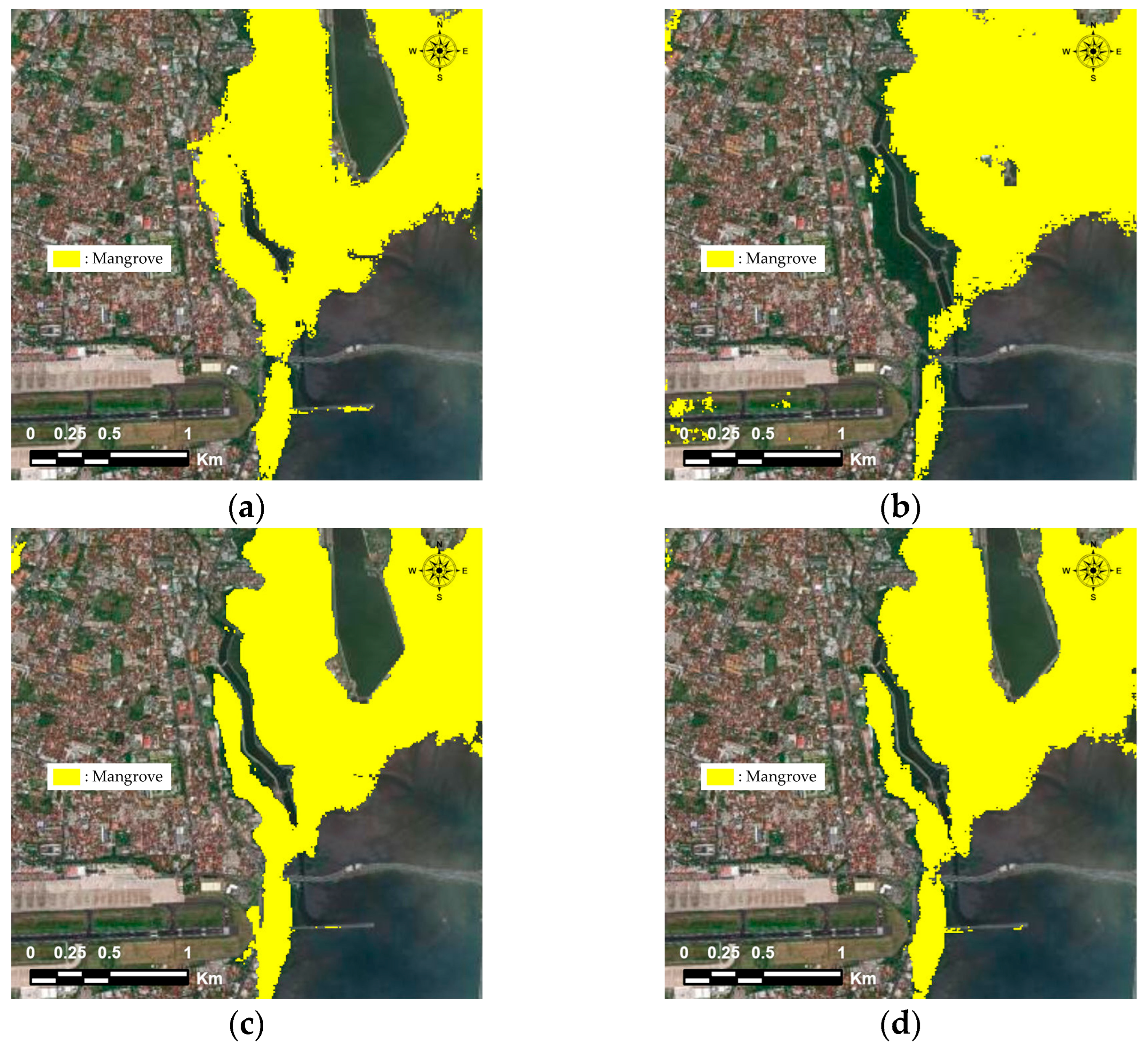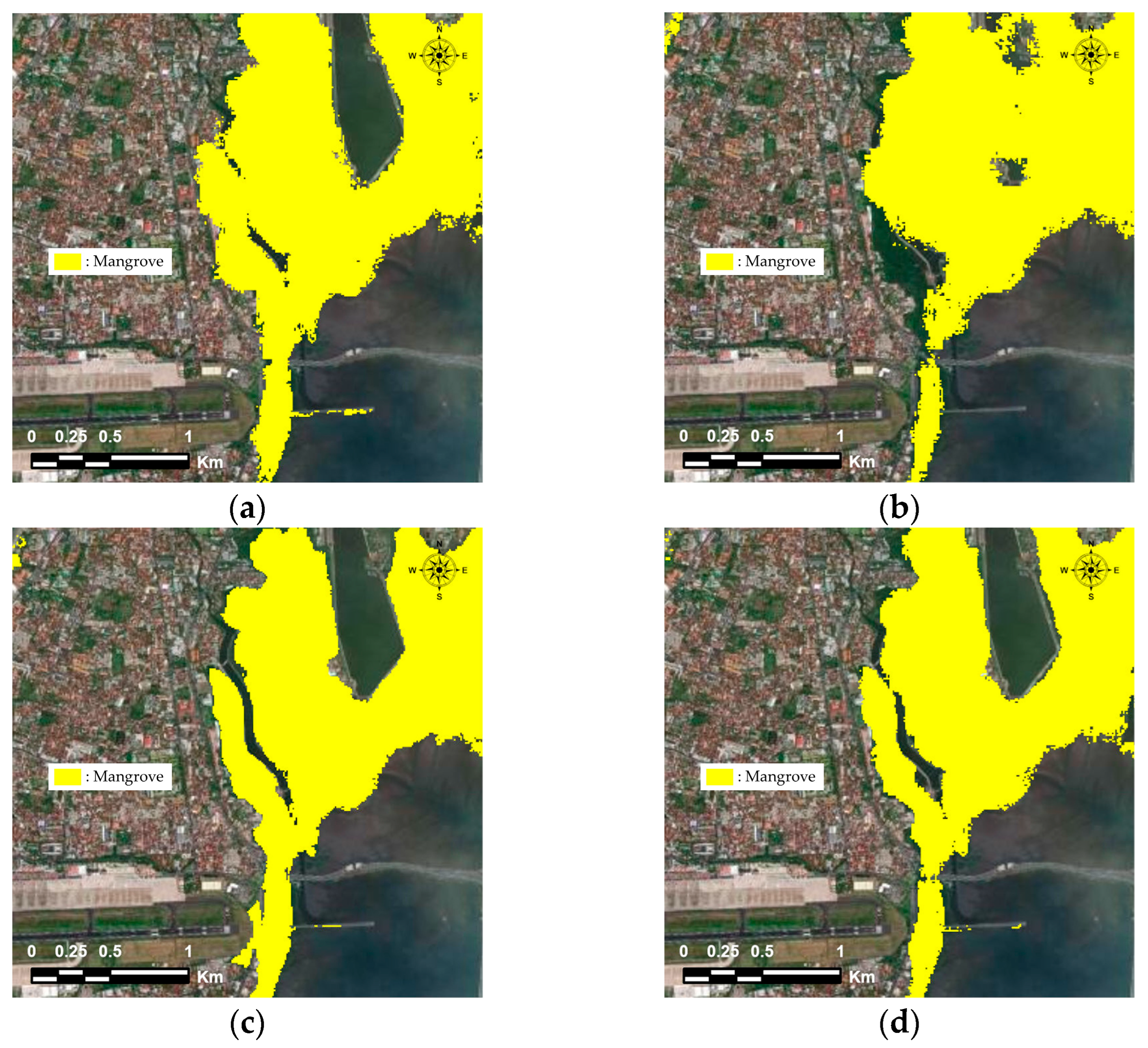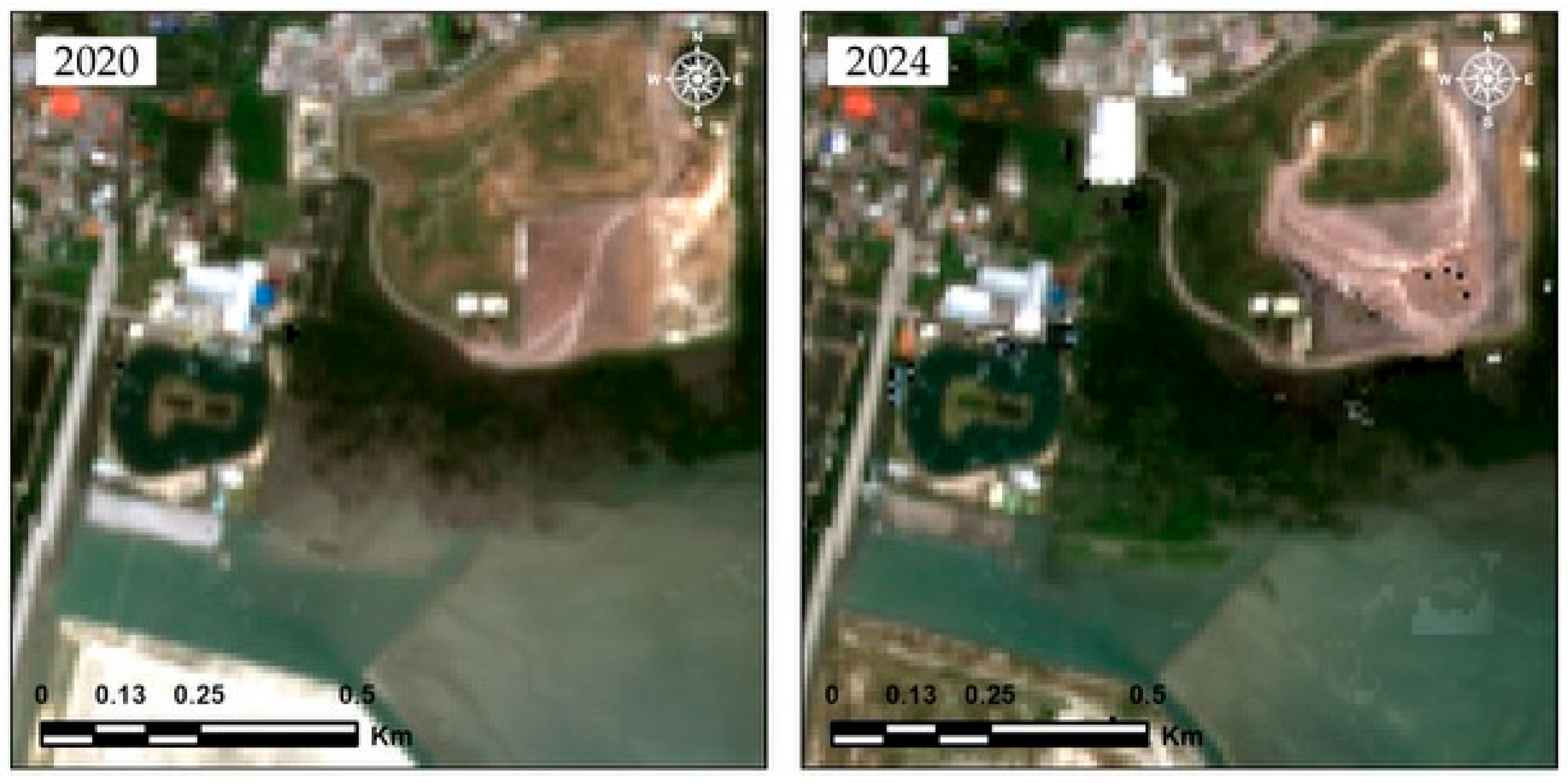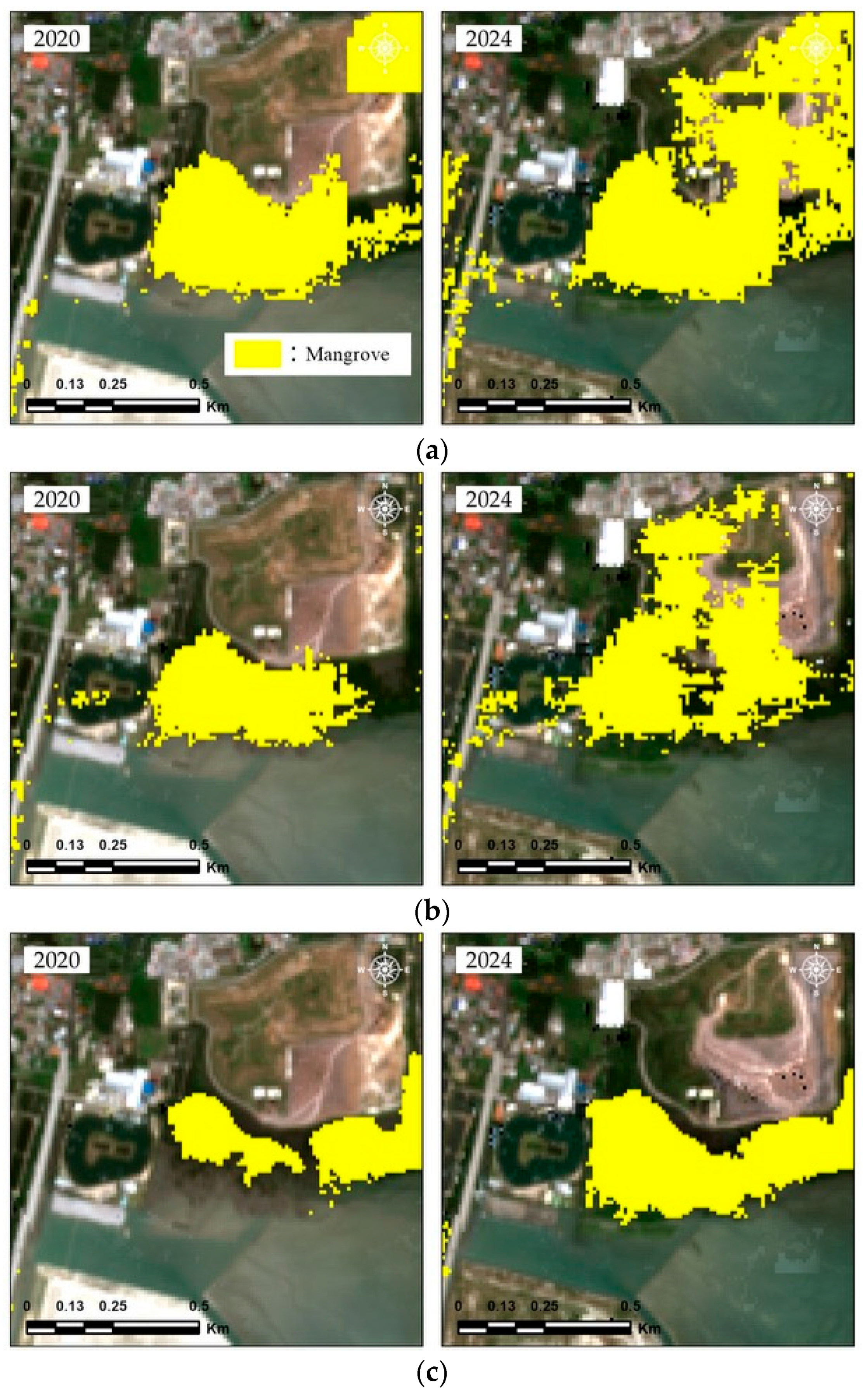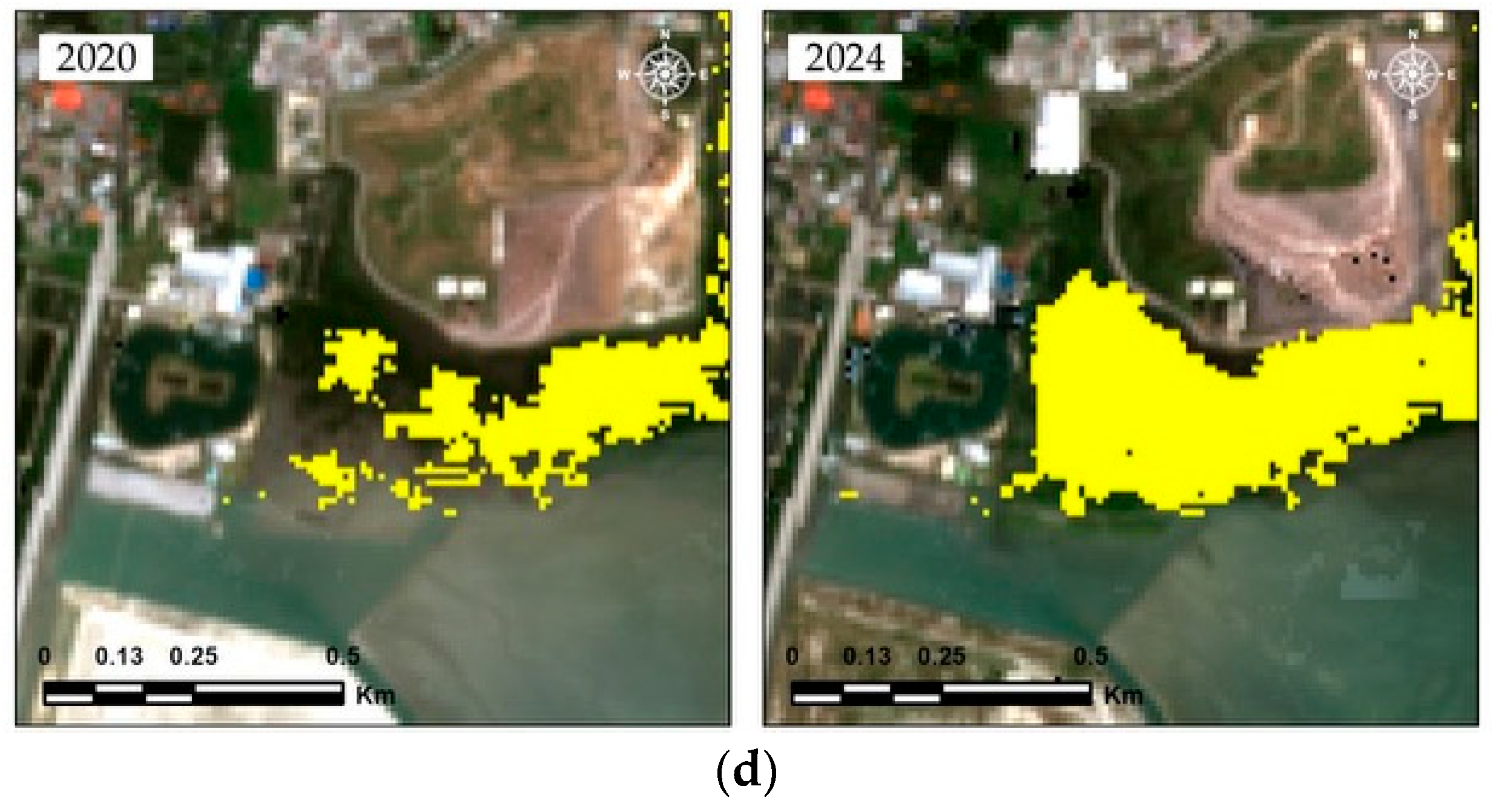1. Introduction
Mangrove forests are evergreen ecosystems that thrive at the interface between land and sea in tropical and subtropical regions and are distinguished by their high tolerance to salinity [
1,
2,
3,
4]. These ecosystems are among the most diverse and dynamic ecosystems in the world, playing a critical role in climate change mitigation and carbon storage because of their exceptional capacity for carbon sequestration [
5]. However, since the 1980s, more than half of the global mangrove forests have experienced a rapid decline driven by commercial logging, fuelwood harvesting, charcoal production, mining activities, agricultural expansion, housing development, and the growth of aquaculture farms [
6]. Asia, in particular, has recorded the highest net loss, with approximately 1.9 million hectares of mangrove forest disappearing since the 1980s [
7]. This substantial decline highlights the urgent need for sustainable mangrove management and conservation efforts on a global scale.
Asia contains the world’s largest mangrove forests, making it a critical region for the preservation and management of global mangrove ecosystems [
8]. Indonesia, in particular, hosts the most extensive mangrove forest area and is widely recognized for its exceptional biodiversity, both in terms of total coverage and species diversity [
9,
10]. Over the past 30 years, the estimated total value of ecosystem services provided by Bali’s mangrove forests has exceeded USD 2 million [
11], underscoring their continuous contribution to ecological functions and ecosystem services. However, with its tourism-driven economy [
12], Bali faces an ongoing challenge in balancing economic growth with environmental conservation efforts. Despite these challenges, the mangrove forests in Bali have remained relatively stable in size over the past decade, increasing slightly from 2122.35 hectares in 2010 to 2146.32 hectares in 2020 [
13]. This stability represents a successful case of harmonizing local economic development with environmental preservation while maintaining the ecological and environmental value of mangrove forests. These characteristics position Bali’s mangrove forests as a model for ecosystem preservation and the promotion of sustainable tourism. Bali’s mangrove conservation efforts serve as a valuable reference for discussing sustainable management strategies at both regional and global levels. Previous studies on mangroves in the Bali region have focused primarily on estimating carbon storage, and research addressing mangrove classification has largely relied on medium-resolution satellite imagery. Accordingly, this study applied a high-resolution classification approach that integrates SAR and optical imagery, combined with deep learning techniques, focusing on the Badung–Denpasar area to improve classification accuracy.
Mangroves exhibit complex vegetation structures and geomorphological characteristics, including intertwined canopies, water bodies, and mudflats, which make it difficult to achieve precise classification using only spectral information [
14,
15]. Deep learning techniques are well-suited for mangrove classification as they can effectively learn such complex and abstract features and can also perform well with relatively limited labeled data. Moreover, mangroves typically occupy a small proportion of the overall area, leading to class imbalance issues that may reduce the classification accuracy. Therefore, satellite-based approaches offer an effective alternative, providing the foundation for accurate monitoring and conservation efforts. However, as most mangrove forests are located in tropical regions, their remoteness and frequent cloud cover often limit the utility of optical imagery alone. To overcome these challenges, the use of synthetic aperture radar (SAR), which can reliably collect data regardless of cloud cover, haze, or time of day, has gained attention. SAR imagery is particularly effective for mangrove classification due to its sensitivity to vegetation structure and moisture content [
16,
17,
18].
This study aimed to improve the classification accuracy through the integration of optical and synthetic aperture radar (SAR) satellite imagery, with particular emphasis on the importance of generalizability. The complementary characteristics of SAR and optical imagery were leveraged to quantitatively assess the effectiveness of data integration. This approach is meaningful in that it enables the precise mapping of the mangrove distribution and area as well as the development of data-driven detection methods to support ecosystem conservation. However, many mangrove-rich countries lack the technical capacity to conduct high-resolution mapping, despite the increasing demand for accurate spatial information on mangrove distribution. Accordingly, this study proposes a classification framework that balances technical sophistication with broad accessibility, aiming to support sustainable mangrove management even in regions with limited technological infrastructure. Although previous studies have demonstrated the potential of SAR–optical data fusion, challenges remain in terms of scalability, consistency, and applicability across diverse environmental settings. In response to these challenges, the present study introduces a high-resolution classification framework that leverages open-access satellite imagery in conjunction with advanced deep learning algorithms. The findings of this study are expected to contribute not only to the advancement of mangrove classification techniques, but also to the development of policies and ecosystem-based conservation strategies.
4. Discussion
This study went beyond simple data fusion by analyzing the respective advantages and limitations of SAR and optical imagery and designing a combined band configuration that reflected these characteristics, thereby distinguishing itself from previous studies. The classification was conducted using only publicly available satellite data—Sentinel-1, Sentinel-2, and ESA WorldCover v100—demonstrating a practical and scalable approach, particularly in regions with limited technical infrastructure. While some earlier studies relied heavily on field-based reference data or high-resolution satellite imagery to enhance classification accuracy [
44], the present study primarily utilized ESA WorldCover and Sentinel imagery, with high-resolution data and field information used only as supplementary inputs. Similarly, although Xie et al. (2024) [
14] achieved high accuracy by comparing multiple deep learning models, their approach as based on Chinese proprietary satellite data, which may limit its generalizability. In contrast, our method was grounded entirely in open-access imagery, offering enhanced scalability and transferability across different regions and conditions. This approach thus presents a framework that balances accessibility, practicality, and classification accuracy. In particular, by conducting a temporal comparison of the classification results and demonstrating that the combined bands improved both the spatial consistency and precision, the study validated the practical utility of SAR–optical integration. The results yielded a high classification accuracy within the study area and suggest the potential applicability of this framework in other environmental contexts.
Notably, due to the lack of official mangrove label data for 2024, high-resolution satellite imagery was visually interpreted to verify the classification results. The model trained on 2020 data was successfully applied to the 2024 imagery, demonstrating its temporal transferability. This result further highlights the model’s potential for practical use in near-real-time mangrove monitoring, especially when up-to-date reference data are unavailable.
The results of this study suggest that the classification performance varies depending on how different band combinations reflect the mangrove vegetation characteristics and their interactions with other environmental factors. To better capture the complex relationship between aquatic mangrove vegetation and environmental indicators, this study integrated optical imagery with SAR data. Since optical and SAR imagery are acquired through different physical mechanisms, combining both data types allows for a more comprehensive representation of the ecological and geographical characteristics, which a single data source may fail to capture. This integration aims to overcome the limitations of single-source data and enhance classification accuracy in complex environments such as mangrove ecosystems.
Additionally, the analysis demonstrated a significant improvement in classification accuracy when mixed bands were used compared with using optical or SAR data alone. This improvement can be attributed to the complementary characteristics of optical imagery and SAR data, which better captured the intricate properties of mangrove vegetation. The water body detection capability of SAR imagery combined with the spectral information from optical bands helped overcome the limitations of using individual data types.
However, when classification was restricted to areas with elevations below 10 m using DEM data, some actual mangrove regions were erroneously excluded, leading to omission errors. In lowland areas with similar spectral and textural characteristics, confusion still remains, especially in agricultural or high-moisture forest zones. The results suggest that the elevation criteria used in the DEM failed to fully capture the diversity and complexity of mangrove habitats, potentially restricting the accuracy of the classification data necessary for conservation and management efforts. To address these limitations, further research is needed to explore additional band combinations and develop new indices that extend beyond the current mixed band approach. In addition, strategies such as incorporating auxiliary datasets or developing region-specific post-processing rules may also be considered to better reflect the local characteristics and environmental conditions.
One of the primary challenges of optical imagery in tropical regions is persistent cloud cover, which limits data acquisition. In contrast, SAR data can operate independently of weather conditions, providing a significant advantage for mangrove classification in such environments. Time-series analysis revealed that VV-VH polarization-based classification provided a stable representation of mangrove area expansion, whereas VV polarization showed a minor decline in mangrove coverage. Despite this, the VV polarization still exhibited high-accuracy coverage, indicating that SAR data alone can be a reliable and effective classification method in cloud-dense conditions. The all-weather observation capability of SAR data makes it a practical alternative for mangrove classification in tropical regions.
However, overestimation was observed when classifying imagery from different years using the trained dataset. This issue is presumed to have resulted from changes in the temporal characteristics of the satellite imagery or discrepancies in the dataset. To ensure accurate time-series analysis, it is essential to develop an optimized methodology that minimizes both overestimation and underestimation by accounting for variations between datasets. To address these limitations, future studies should focus on refining the correction processes to further improve the classification accuracy.



